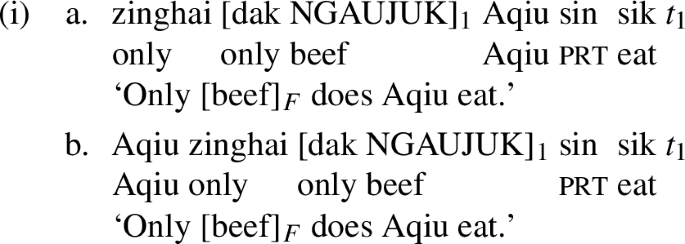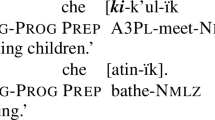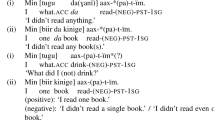Abstract
This paper provides cross-linguistic support for a bipartite analysis of ‘only’ (Bayer in Directionality and logical form: on the scope of focusing particles and Wh-in-situ, Springer, Dordrecht 1996; Kayne in Syntax 1:128–191, 1998; Lee in Nat Lang Semant 13:169–200, 2005; Horvath in: Simin et al. (eds) Phrasal and clausal architecture: syntactic derivation and interpretation, John Benjamins, Amsterdam, 2007; Barbiers in Linguistic variation in the minimalist framework, Oxford University Press, Oxford, 2014; Quek and Aron, in: Lamont and Tetzloff (eds) Proceedings of NELS 47, University of Massachusetts, Graduate Linguistic Student Association, Amherst, 2017) by showing that it can be extended to account for all the properties of a focus particle—zhiyou ‘only’ in Mandarin Chinese. It proposes that zhiyou spells out one of the heads within a bipartite structure of ‘only’ and the other covert head that co-occurs with it on the clausal spine determines the semantic scope of ‘only’. The current proposal improves on a previous version of bipartite analysis (Hole in J East Asian Linguist 26:389–409, 2017: A crosslinguistic syntax of scalar and non-scalar focus particle sentences: the view from Vietnamese and Chinese) by discarding the view that zhiyou and the particle cai form a Spec-Head relation, which enables us to cover a wider range of empirical data. Instead, the paper identifies the adverbial zhi ‘only’ as a possible candidate that overtly realizes the Foc head, and supports the bipartite analysis based on the cross-linguistic parallel between Mandarin and Vietnamese, which share a similar inventory of ONLY-related particles.
Similar content being viewed by others
Notes
Bayer does not use ‘Foc’ and ‘Q’ to label the two focus-related heads in his papers. The labels in the analyses cited in this paper are all adjusted so that different analyses can be compared straightforwardly.
In this paper I follow Hole (2017) and many others in assuming that zhiyou can be a single word. In fact, since zhi can be independently used as an adverbial particle ‘only’ and you can be an existential verb in Mandarin, it is possible that some zhiyou-constructions can be analyzed as the adverbial zhi modifying the verb you. However, this analysis cannot extend to all the data involving zhiyou as zhiyou can be ad-prepositional, whereas an existential verb can only take DP arguments but not PP ones. In addition, when the existential verb you occurs in the sentence-initial position to form an existential construction, it exhibits the ‘Definiteness Effect’ (Milsark 1974); but the sentence-initial zhiyou does not exhibit this effect, as shown by (8a).
When zhiyou attaches to a clause as in (8c), it somehow yields a conditional meaning ‘only if’. This use is slightly different from the cases in which zhiyou adjoins to DPs and PPs in that cai is always required. I will not go into this use of zhiyou in this paper since its meaning is far beyond the basic exclusiveness semantics of ‘only’, although see a recent discussion of the exclusive jiu on its conditional use (Liu 2017).
This contrasts with another particle that expresses the meaning of ‘only’ in Mandarin—the adverbial particle zhi. The particle zhi behaves largely like the English adverbial only in that it involves in-situ focus, as in (i).

We will briefly discuss zhi in Sect. 5.
Some of my informants report that (23a) or (23b) are marginally acceptable. However, notice the reading we are interested in is the bound variable reading, namely ‘I’ve only introduced John\(_i\) to his\(_i\) boss, but not others to their boss’, instead of the coreferential reading ‘I’ve only introduced John\(_i\) but not others to his\(_i\) boss’. The sentence is degraded under the bound variable reading.
In Sect. 5.1, I will discuss another possible implementation of the bipartite analysis in which the QP is attracted to the complement of the Foc head via ‘Undermerge’ (Pesetsky 2007; Yuan 2017), motivated by the word order of the two heads in a language (Vietnamese) that allows overt realization of both heads in the bipartite structure.
One reviewer points out that for sentences involving the cross-clausal movement of a zhiyou-phrase, those with a clause-initial zhiyou on the surface generally sound better than those with a post-subject zhiyou. The current analysis does not capture this contrast since the derivations of those two constructions involve more or less the same steps: the attachment of the Foc head to a clausal spine, and the Ā-movement of the zhiyou-phrase. As noted by the reviewer, this contrast also holds for the cross-clausal movement of a nominal phrase without zhiyou, which casts doubt on the current assumption that the post-subject position is an Ā-position (see Sect. 2.2).

While it is beyond the scope of this paper to offer a detailed explanation, one suggestion I have is that maybe this contrast can be explained by the difference in the information structure of those two constructions rather than the difference in their syntax. The reason is that the contrast is not categorical in many examples in the first place, and adding an appropriate continuation can often improve the degraded ones as in (ii).

For those who find the two readings in (60) a bit hard to distinguish, it is useful to compare (60) with the sentence in (i). Extending Bayer’s analysis to Mandarin predicts that the two should have the same scope relation for ‘only’ and the modal. But the two do not sound equivalent.

It is worth noting that the constraint in (65) is closely related to two generalizations made in the literature. One is the Generalized Anchoring Principle proposed in Tang and Lee (2000). They observe that Chinese sentences can sound ‘incomplete’ (marked by ‘%’), especially those involving a bare predicate (without any aspectual markers) like (i), and adding ‘something’ to such sentences will make them better.

The other generalization is that a preposed object in the post-subject position generally requires a ‘contrastive’ interpretation (Ernst and Wang 1995; Lu 1994; Qu 1994; Shyu 1995) such that it sounds incomplete without a contrastive clause as in (ii):

As pointed out by one reviewer, there is some constraint on the structural relation between zhiyou and cai such that the two must be clause-mates as shown in (i), which is suspicious for an adjunct analysis of cai at first sight. But a similar clause-mate constraint for the adjunct can also be found with English if ... then ... conditional as in (ii), though the if-antecedent and the particle then are also not analyzed as Spec-Head relation (Bhatt and Pancheva 2006).


The fact that zhiyou in fact has a conditional use (though not discussed in the current paper) suggests such a connection is not a random, or stipulative one.
The particle
 (not to be confused with adfocus
(not to be confused with adfocus  ) can be viewed as the counterpart of cai as discussed in Hole (2017), and while Hole argues that
) can be viewed as the counterpart of cai as discussed in Hole (2017), and while Hole argues that  is near-obligatory like cai, we’ve shown that in Mandarin cai is in fact optional. It is beyond the scope of this paper to have a detailed investigation of when
is near-obligatory like cai, we’ve shown that in Mandarin cai is in fact optional. It is beyond the scope of this paper to have a detailed investigation of when  is optional, but my consultants confirmed that at least when the focus associate is pre-verbal (i.e. the subject),
is optional, but my consultants confirmed that at least when the focus associate is pre-verbal (i.e. the subject),  is fully optional in the sentences involving adfocus
is fully optional in the sentences involving adfocus  and there is a difference in meaning between the sentence with
and there is a difference in meaning between the sentence with  and that without it. The optionality suggests that
and that without it. The optionality suggests that  is apparently ‘near-obligatory’ in Vietnamese for independent reasons just like cai is in Mandarin.
is apparently ‘near-obligatory’ in Vietnamese for independent reasons just like cai is in Mandarin.In Cantonese, zinghai (the counterpart of adverbial zhi), and dak (the counterpart of adfocus zhiyou), can also co-occur and they observe the ‘only\(_{Adv}\)-only\(_{Adf}\)’ word order just like Vietnamese (p.c. Jackie Yan-Ki Lai, Ka-Fai Yip):

The co-occurrence phenomena in a Chinese language such as Cantonese provides further support for the bipartite analysis of ‘only’ in Mandarin Chinese.
References
Alleton, Viviane. 1972. Les Adverbes En Chinois Moderne. Den Haag & Paris: Mouton & Co.
Barbiers, Sjef. 2010. Focus particle doubling. In Structure Preserved. Studies in syntax for Jan Koster, edited by C. Jan-Wouter Zwart and Mark de Vries, 21–30. John Benjamins.
Barbiers, Sjef. 2014. Syntactic doubling and deletion as a source of variation. In Linguistic Variation in the Minimalist Framework, 197–223. Oxford: Oxford University Press.
Bayer, Josef. 1996. Directionality and Logical Form: On the Scope of Focusing Particles and Wh-in-situ, vol. 34. Dordrecht: Springer.
Bayer, Josef. 2018. Criterial Freezing in the syntax of particles. In Freezing: Theoretical Approaches and Empirical Domains, edited by Jutta Hartmann, Marion Jäger, Andreas Kehl, Andreas Konietzko, and Susanne Winkler, 225–263. De Gruyter Mouton.
Bayer, Josef. 2019. Why doubling discourse particles? In Linguistic Variation: Structure and Interpretation, edited by Ludovico Franco and Paolo Lorusso, 47–72. De Gruyter Mouton.
Beaver, David I., and Brady Z. Clark. 2008. Sense and Sensitivity: How Focus Determines Meaning, volume 12. Wiley-Blackwell.
Bhatt, Rajesh, and Roumyana Pancheva. 2006. Conditionals. In The Blackwell Companion to Syntax, edited by Martin Everaert and Henk van Riemsdijk, 638–687. Wiley Online Library.
Biq, Yung-O. 1984. The Semantics and Pragmatics of CAI and JIU in Mandarin Chinese. Doctoral Dissertation, Cornell University.
Biq, Yung-O. 1988. From Focus in Proposition to Focus in Speech Situation: CAI and JIU in Mandarin Chinese. Journal of Chinese Linguistics 16: 72–108.
Büring, Daniel, and Katharina Hartmann. 2001. The Syntax and Semantics of Focus-Sensitive Particles in German. Natural Language & Linguistic Theory 19: 229–281.
Cable, Seth. 2010. The Grammar of Q: Q-particles, Wh-Movement, and Pied-Piping. Oxford: Oxford University Press.
Chomsky, Noam. 1995. The Minimalist Program. Cambridge, MA: MIT Press.
Erlewine, Michael Yoshitaka. 2015. In Defense of Closeness: Focus-Sensitive Adverb Placement in Vietnamese and Mandarin Chinese. Manuscript: McGill University.
Erlewine, Michael Yoshitaka. 2017. Vietnamese Focus Particles and Derivation by Phase. Journal of East Asian Linguistics 26: 325–349.
Ernst, Thomas, and Chengchi Wang. 1995. Object Peposing in Mandarin Chinese. Journal of East Asian Linguistics 4: 235–260.
Hole, Daniel. 2004. Focus and Background Marking in Mandarin Chinese: System and Theory Behind Cai, Jiu, Dou and Ye. Milton Park: Routledge.
Hole, Daniel. 2008. EVEN, ALSO and ONLY in Vietnamese. In Interdisciplinary Studies in Information Structure, ed. Shinichiro Ishihara, Svetlana Petrova, and Anne Schwarz, 1–54. Potsdam: Universitätsverlag Potsdam.
Hole, Daniel. 2013. Focus particles and related entities in Vietnamese. In Linguistics of Vietnamese: An International Survey, 265–303. Berlin: Walter de Gruyter.
Hole, Daniel. 2017. A Crosslinguistic Syntax of Scalar and Non-scalar Focus Particle Sentences: The View from Vietnamese and Chinese. Journal of East Asian Linguistics 26: 389–409.
Horvath, Julia. 2007. Separating focus movement from focus. In Phrasal and Clausal Architecture: Syntactic Derivation and Interpretation, ed. Simin Karimi, Vida Samiian, and Wendy K. Wilkins, 108–145. Amsterdam: John Benjamins.
Huang, C.-T., Y.-H. James, Audrey Li, and Yafei Li. 2009. The Syntax of Chinese. Cambridge: Cambridge University Press.
Jackendoff, Ray S. 1972. Semantic Interpretation in Generative Grammar. Cambridge: MIT Press.
Kayne, Richard S. 1998. Overt vs. Covert Movements. Syntax 1: 128–191.
Lai, Huei-Ling. 1995. Rejected Expectations: The Two Time-related Scalar Particles CAI and JIU in Mandarin Chinese. Doctoral Dissertation, University of Texas at Austin.
Lai, Huei-Ling. 1999. Rejected Expectations: The Scalar Particles Cai and Jiu in Mandarin Chinese. Linguistics 37: 625–661.
Lee, Youngjoo. 2005. Exhaustivity as Agreement: The Case of Korean Man ‘ONLY’. Natural Language Semantics 13: 169–200.
Li, Charles N., and Sandra A. Thompson. 1981. Mandarin Chinese. A Functional Reference Grammar. Berkeley: University of California Press.
Li, Yen-Hui Audrey. 2014. Quantification and Scope. In The Handbook of Chinese Linguistics, edited by C.-T. James Huang, Y.-H. Audrey Li, and Andrew Simpson, 208–247. Wiley Online Library. https://doi.org/10.1002/9781118584552.ch9.
Liu, Mingming. 2017. Mandarin Conditional Conjunctions and Only. Studies in Logic 10: 45–61.
Lu, Hui-chuan. 1994. Second Preverbal NPs in Chinese. In 6th North American Conference on Chinese Linguistics (NACCL-6), edited by Josè Camacho and Lina Choueiri.
Milsark, Gary L. 1974. Existential Sentences in English. Doctoral Dissertation, MIT, Cambridge.
Pesetsky, David. 2007. Undermerge... and the Secret Genitive Inside Every Russian Noun. Handout of a talk at FASL 16.
Pesetsky, David. 2013. Russian Case Morphology and the Syntactic Categories, vol. 66. Cambridge, MA: MIT Press.
Qu, Yanfeng. 1994. Object Noun Phrase Dislocation In Mandarin Chinese. Doctoral Dissertation, University of British Columbia.
Quek, Yihui, and Aron Hirsch. 2017. Severing focus form and meaning in Standard and Colloquial Singapore English. In Proceedings of NELS 47, edited by Lamont Andrew and Tetzloff Katerina. Amherst: University of Massachusetts, Graduate Linguistic Student Association.
Richards, Norvin. 2001. Movement in Language: Interactions and Architectures. Oxford: Oxford University Press.
Rizzi, Luigi. 2006. On the form of chains: Criterial positions and ECP effects. In Wh-Movement: Moving on, edited by Lisa Lai-Shen Cheng and Norbert Corver, volume 42, 97–133. MIT Press. https://doi.org/10.7551/mitpress/7197.001.0001.
Rooth, Mats. 1985. Association with Focus. Doctoral Dissertation, University of Massachusetts Amherst.
Rooth, Mats. 1992. A Theory of Focus Interpretation. Natural Language Semantics 1: 75–116.
Shyu, Shu-Ing. 1995. The Syntax of Focus and Topic in Mandarian Chinese. Doctoral Dissertation, University of Southern California Los Angeles.
Sun, Yenan. 2020. Only-concord in Vietnamese: Support for a bipartite analysis and Undermerge. In Proceedings of the 50th Annual Meeting of the North East Linguistic Society, ed. Mariam Asatryan, Yixiao Song, and Ayana Whitmal, volume 3, 183–192.
Taglicht, Josef. 1984. Message and Emphasis: On Focus and Scope in English, vol. 15. Boston, MA: Addison-Wesley Longman Limited.
Tang, Sze-Wing, and Thomas H.-T. Lee. 2000. Focus as an Anchoring Condition. Handout of talk given at the International Symposium on Topic and Focus in Chinese, The Hong Kong Polytechnic University, June 21–23, 2000.
Wagner, Michael. 2006. Association by Movement: Evidence from NPI-Licensing. Natural Language Semantics 14: 297–324.
Yuan, Michelle. 2017. Movement to Complement in Kikuyu and the Syntax of Focus Association. MS, Massachusetts Institute of Technology. Available via https://quote.ucsd.edu/myuan/papers/.
Zanon, Ksenia, and Yu-Yin Hsu. 2019. Focus Movement and Association with ONLY in Russian and Chinese. In Proceedings of the 49th Annual Meeting of the North East Linguistic Society, edited by Maggie Baird and Jonathan Pesetsky.
Acknowledgements
I would like to thank Karlos Arregi for his insightful feedback and Michael Yoshitaka Erlewine, Anastasia Giannakidou, Jackie Yan-Ki Lai, Ming Xiang, Michelle Yuan, Erik Zyman, and audiences at LSA 94 and NELS 50 for helpful discussion. My sincere thanks go to Daniel Lam, Cam Ha Nguyen and Thu Nguyens for their judgments on Vietnamese data and Jackie Yan-Ki Lai for the discussion on Cantonese syntax. Special thanks go to the two anonymous reviewers of Journal of East Asian Linguistics and the editors for their constructive comments. All remaining errors are my own.
Author information
Authors and Affiliations
Corresponding author
Additional information
Publisher's Note
Springer Nature remains neutral with regard to jurisdictional claims in published maps and institutional affiliations.
Rights and permissions
About this article
Cite this article
Sun, Y. A bipartite analysis of zhiyou ‘only’ in Mandarin Chinese. J East Asian Linguist 30, 319–355 (2021). https://doi.org/10.1007/s10831-021-09228-w
Received:
Accepted:
Published:
Issue Date:
DOI: https://doi.org/10.1007/s10831-021-09228-w













 (not to be confused with adfocus
(not to be confused with adfocus  ) can be viewed as the counterpart of cai as discussed in Hole (
) can be viewed as the counterpart of cai as discussed in Hole ( is near-obligatory like cai, we’ve shown that in Mandarin cai is in fact optional. It is beyond the scope of this paper to have a detailed investigation of when
is near-obligatory like cai, we’ve shown that in Mandarin cai is in fact optional. It is beyond the scope of this paper to have a detailed investigation of when  is optional, but my consultants confirmed that at least when the focus associate is pre-verbal (i.e. the subject),
is optional, but my consultants confirmed that at least when the focus associate is pre-verbal (i.e. the subject),  is fully optional in the sentences involving adfocus
is fully optional in the sentences involving adfocus  and there is a difference in meaning between the sentence with
and there is a difference in meaning between the sentence with  and that without it. The optionality suggests that
and that without it. The optionality suggests that  is apparently ‘near-obligatory’ in Vietnamese for independent reasons just like cai is in Mandarin.
is apparently ‘near-obligatory’ in Vietnamese for independent reasons just like cai is in Mandarin.